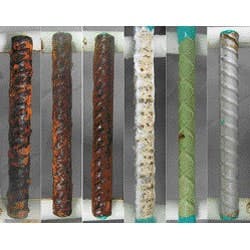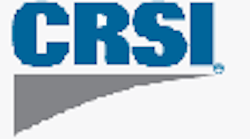Eight types of steel reinforcing bars studied were uncoated ASTM A615 bars; new ASTM A775 epoxy-coated bars (ECR); 15-year old ASTM A775 epoxy-coated bars; ASTM A1035 low carbon, chromium bars; ASTM A767 galvanized bars; ASTM A240 3Cr12 bars (a lean stainless steel); and ASTM A955 stainless steel 2201, 2205 and 316LN bars. Bar samples were exposed to 5% NaCl solution fog at 35°C for 672 hours. The corresponding corrosion was documented by weight and visual inspection. The bars can be divided into four groups based on their corrosion rates: Uncoated ASTM A615 and A767 galvanized bars – very high corrosion rate; ASTM A1035 Low Carbon, Chromium and ASTM A240 3Cr12 – moderate corrosion rate; ASTM A955 2201 – low corrosion rate; and New and 15-year old ASTM A775 ECR, ASTM A955 316LN and 2205 – minor corrosion rate.

